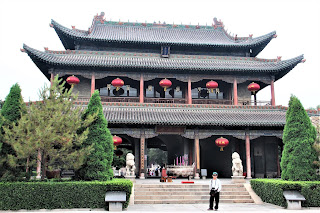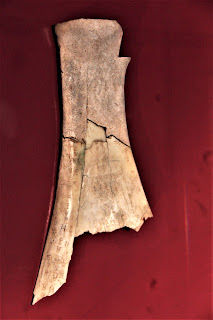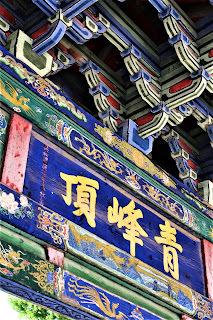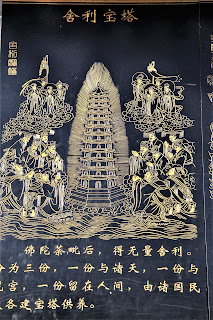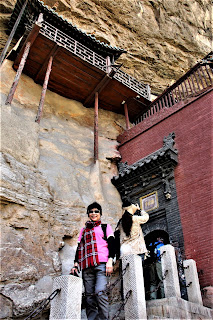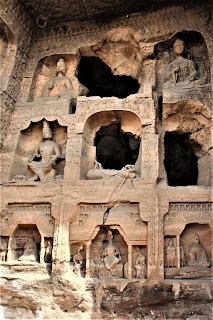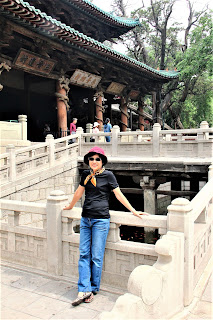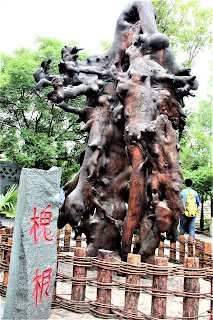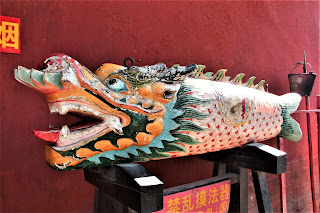(Part B) The main attractions in ancient history and culture, the oldest comes first
(B1) Yao Temple 尧庙 at Linfen 临汾
Emperor Yao 尧帝, though respectfully given the title of Emperor by historians, was a tribal chief living around 2356 BC to 2255 BC. His empire covered part of present-day Hebei and Shanxi provinces. He was said to be a very wise ruler, retired at the age of 90 and passed the helm to another wise man instead of to any of his sons. His capital was Pingyang 平阳, present-day Linfen in Shanxi.
The first memorial temple of Emperor Yao at Linfen was built in 685 AD. The present buildings are dated to the Qing Dynasty, mostly 200+ years old. Shown the 1st 2 entrance gates, 1 of the many re-built antique vessels that lined the entrance passageway, and 1 of the 4 old Cypress trees in the courtyard, said to be older than 1,500 years.
The 2 main buildings are the 5-Phoenix Hall 五风楼 and the Guangyun Palace 广运殿. Shown the external façade of the former and the statues in the latter, those of the Emperor Yao and his 2 prime ministers.
(B2) Archaeological site at Yinxu 殷墟
The place called Yinxu 殷墟was the capital of the Shang Dynasty 商朝 from 1300 BC to 1046 BC. It is located in the modern city of Anyang 安阳in the northern Hebei province. The most important relics found in this place are the bone oracles甲骨文, from which the modern Chinese scripts have evolved. Formal excavation of the area started in 1928.
Organised large scale excavation with government support only started in the 1950s and still on going. The excavation uncovered ruins of over 50 structures, including palatial buildings and royal tombs, and over 150,000 pieces of oracle bones.
The Archaeological site at Yinxu is a UNESCO World Heritage site. We visited the museum and parts of the excavation area. Shown some items from the museum: a bone piece and samples of the oracle script, a jade pendent, and a marker at the archaeological site.
More from the museum: a clay 3-pipe joint, a clay steamer, a bronze axe and a giant vessel called the "Simuwu Ding" 司母戊鼎. This is a ceremonial rectangular vessel with the inscription of the word “Simuwu” 司母戊.
This huge vessel is 133 cm high, 116 cm long, 79 cm wide, 875 Kg in weight. It is the largest bronze vessel unearthed in China. This one at the museum is a replica though. The original is kept at the Chinese National Museum in Beijing.
Do note that all the pieces are over 3,000 years old.
(B3) Wutaishan 五台山
Wutaishan is the name of a group of 5 mountains in north-east Shanxi. Buddhist temples have been built on the peaks of each of these mountains as well as on the central basin. The first temple was built around 68 AD, during the Han Dynasty 汉朝. The town at the basin is named Taihuai 台怀. The group of temples are called Wutaishan Temples, one of the 4 most sacred Buddhist temple groups in China. This is a UNESCO World Heritage site
The Wutaishan Temples are devoted to Bodhisattva Manjusri 文殊菩萨. In Mahayana Buddhism practised in China they revere bodhisattvas, the highest being before reaching Buddhahood. In southern China, Buddhists revere Bodhisattva Guanyin 观音菩萨, but in the north it is more of Bodhisattva Manjusri. Guanyin is Compassion, Manjusri is Wisdom.
Pusading 菩萨顶
We visited several temple complexes in Taihuai, the central basin. The most important temple group is Pusading 菩萨顶 devoted to Bodhisattva Manjusri. The main halls are very ornately decorated, quite unusual.
菩萨顶 -- 康熙
四十余年礼世伽,本来面目是天家。清凉无物何所有,叶斗峰横问法华。
Xiantongsi 显通寺
Xiantongsi 显通寺 is the largest temple complex at Wutaishan, with over 400 buildings, including 7 main halls. It is the 2nd oldest Buddhist temple in China. The most famous structure is the bronze hall housed inside the main building in the 1st photo. The hall, 8.3 m high, 4.7 m wide and 4.5 m deep was cast of bronze, the only surviving one out of 3 cast in the year 1609 as initiated by the reigning emperor's mother. The other 2 were placed at other temples and were lost. The interiors of the main halls were decorated with many Buddha statues, including a bronze statue of Bodhisattva Manjusri with a thousand hands.
Dailuoding 黛螺顶
And 4 photos taken at another temple group at Dailuoding 黛螺顶, located on a 400-m high peak.
(B4) The hanging temple of Xuankongsi 悬空寺
This famous temple is located at a gorge within the mountain range called Beiyue Hengshan 北岳恒山in northern Shanxi. It was first built in 491 AD during the Northern Wei 北魏period. It was built on the cliff face some 90 m above the river bed. Due to silting of the gorge it is now 60 m above the river bed. The main buildings are rather narrow, narrowest might be 5 m. They are supported by cantilever timber beams embedded into the rocks. About 2-thirds of a beam is inside the rock. The slender poles which look like columns are in fact more of a cosmetic function.
程世利
殿阁四十间, 蛛丝擎天石. 风吹寺若坠, 雪飘浸汗滴.
肚怀佛道儒, 空悬乐画诗. 心若似磐石, 不怕水流急.
This is also an over-hyped tourist attraction. Shown a distant view of the temple to showcase its location on the cliff, a near view of the main hall, a shot of the narrow buildings and the cosmetic poles, and roof lines of some buildings.
Both Taoist and Buddhist deities are worshiped here, in separate halls of course.
(B5) The caves of Yungang Grottoes 云岗石窟
This is one of the 4 main grottoes in China, a UNESCO World Heritage site. It is located near the city of Datong in northern Shanxi. The first cave was dug in 453 AD during the Northern Wei 北魏period. The initial caves were commissioned by the royalties, the later and smaller ones by rich commoners. Most of them were dug by 491. More than 200 caves were dug but now only 45 are still standing, with more than 250 niches and 51,000 Buddha images.
冰心
万亿化身, 罗刻满山, 鬼斧神工, 骇人心目.
Shown a shot of the general area, the 4-storey "protective" timber façade, built in the 1560s, over Cave 5 and Cave 6, and the Buddha images in Cave No 20, the most popular cave for photo shoot. The statue here is the seated Gautama Buddha (Shakyamuni), 13.7 m tall. Note the great “workmanship” of the carving.
Next are images of 3 caves. Look like the Buddha image in the 2nd photo is wearing a "tie". It is to be noted that the rulers of Northern Wei were not "Han" Chinese but the minority tribe Xianbei 鲜卑族. The faces of some of the Buddhas were carved to resemble these emperors. Some tribal costumes were incorporated in the carved images. When President Nixon visited this place in 1972, his tour guide was Premier Zhou Enlai 周恩来. And the story says Zhou pointed out to the US president that wearing a "tie" was an old Chinese tradition. Of course the story could not be confirmed.
And two shots for remembrance: a sub-group photo with 3 engineers, a high school classmate, a university classmate and a qigong practice group classmate, and their spouses, and a trivial shot of geometry.
(B6) Jinci (or Jin Shrine) 晋祠at Taiyuan
Around 1060 BC, Tang Shuyu唐叔虞, a son of Emperor Zhou Wuwang
周武王was given the region comprising present-day Shanxi to rule as a feudal state. This kingdom is later called "Jin 晋". A temple to honour the wise Shuyu was first founded in the early 6th century at the present site in the city of Taiyuan in central Shanxi. From 984 to 1011 during the Song Dynasty it was greatly expanded and the main figure to be honoured became Shuyu's mother, Empress Yijiang 邑姜. Hence the main hall became known as the Mother Goddess Hall 圣母殿. This is purely a huge temple complex of ancestor worship and culture, little to do with Taoism or Buddhism.
This temple complex is a chest of exceptional treasure of culture and history, many buildings are almost a thousand years old, including the main hall. The 8 carved wooded dragon coiled around the 8 columns, made in 1086, are the oldest of this type in China. Another top treasure is the group of 43 life-size statues of maids in the Mother Goddess Hall. 41 of them were made around 1087 during the Song Dynasty. No photography was allowed in the hall. There is another group of life-size statues of musicians dated to the Yuan Dynasty (1279-1368) at a side building. No photography allowed too but I illegally stole a few.
李白
时时出向城西曲,晋祠流水如碧玉。浮舟弄水箫鼓鸣,微波龙麟莎草绿。
There are other famous old things here. One is the ever-flowing Nanlao Spring 难老泉. Shown the ceiling of the pavilion at the spring. Then a couple of very old tress. The tilting cypress 柏树 was from the Zhou 周period while the pagoda tree 槐树 was from the Tang 唐period. 3,000 and 1,500 years old respectively. They are known as 周柏唐槐.
戴王命
悬瓮山前别有天,滔滔活水几经年?古今多少兴亡事,天地同流难老泉。
This is a huge place. Shown are a few more famous sights. First 2 photos show the opera house. Then a rectangular fish pond and 1 of the 4 giant iron men in a pavilion facing a secondary entrance gate. And two photos of the parks.
(B7) Guan Yu Temple 关帝庙in Haizhou 解州
Guan Yu 关羽 (160 - 219 AD) was a warrior of the Shu State 蜀国during the Three-Kingdom 三国 period, famous for his royalty and integrity. He was born near the present township of Haizhou in the city of Yuncheng 运城in south-west Shanxi. There are many Guan Yu temples in China and around the world. This one at his hometown in Haizhou is considered The Guan Yu Temple. The first temple here was built in the year 589. Most of the present buildings are less than 300 years old.
吕子固
正气充盈穷宇宙, 英灵烜赫几春秋. 巍然庙貌环天下, 不独乡关祀典修.
Shown the entrance pavilion, the Union Pavilion 结义园, the main hall and the plague with the words of 神勇 (meaning "extremely brave") calligraphed by Emperor Qianlong 乾隆in 1752. On a drizzling day.
A general view, a mural painting, a pavilion and a giant incense burner. Guan Yu was a real historic figure, but over the years he has been romanticised and later deified.
(B8) The migration station at the ancient giant pagoda tree at Hongdong 洪洞大槐树
In the last years of the Yuan Dynasty 元朝 there were uprisings and wars everywhere in central China. But Shanxi was relatively peaceful, shielded by the Yellow River and high mountains.
When Zhu Yangzhang 朱元璋 overthrew the Yuan regime and established the Ming Dynasty 明朝 (1368 -1644) he thought the over-populated Shanxi area could be a trouble spot. So he decreed a scheme to force the Shanxi people to migrate to other southern states the population of which has been decimated by war. The migration administration centre was located at this place called Hongdong 洪洞, under a giant pagoda tree, in present day the city of Linfen 临汾 in south west Shanxi. History records showed that there were 15 separate migration schemes implemented in Shanxi during the whole of the Ming Dynasty. And Hongdong was the centre for most of them. Later generation of the migrants came back to find their roots by establishing a memorial at the spot of the giant pagoda tree.
问我老家在何处,山西洪洞大槐树.
The giant pagoda tree has since "died" and the 2nd generation pagoda tree, several hundred years old, has been fenced up for protection. Shown the roots of a tree, said to be those of the original giant pagoda tree, and the 2nd generation tree, and a reflection wall at the entrance. The big word is 根or "root" while the other words are 饮水思源 meaning "grateful to the source". In ancient Chinese architecture, immediately behind the main entrance of a residence or office is a wall to shield the interior from public view. The wall also blocks any direct cold wind as well as evil spirits. This wall is called the reflection wall 照壁. At our time of visit there was a show going on enacting the migration scenes, the last photo. The giant tree is not a real tree.
(Part C) Trivia: shots of funny moments or situations encountered.
The wedding lunch
In China, at least in the northern region, the wedding meal is a lunch. Wedding dinners are for those re-marrying 第二春. The function will be accompanied by the exploding of fire-crackers or even cannon shots (fakes of course), and the restaurant entrance decorated with inflated welcoming balloons.
The giant car transporter and a mini fire truck
This double-decker trailer can transport more than 30 compact cars in one go. These giant 6-axle, 24-tyre trailers are standard heavy vehicles seen in Shanxi. The motorcycle seen inside the Qiao Mansion is in fact a fire engine with hose connection, etc, to be used in the narrow alleys in the mansion with hundreds of buildings.
The National Tourism Day
We were in Wutaishan on Sunday, 19th May 2013, the National Tourism Day in China. Entrance fees in tourist attractions are very expensive in China. It is free on this day for the locals. So it was a very crowded day at Wutaishan. We have never encountered such big crowds before in our many visits to China. Like their golden week crowd.
The toilets
Unlikely but true, in the past the condition of toilets was a determining factor whether one would like to join a tour to China or not. We ourselves have encountered toilets of very poor and unhygienic conditions, without doors, no water, etc.
On this trip we encountered toilets of widely varying standards. Those in the hotels no issue at all as they are 4- and 5-star hotels. But some public toilets are still without doors. Shown one with a very well decorated interior, painted with calligraphic citations of famous poems everywhere, even above the urinals. In another place, in the man's toilet pails are used to collect urine as fertilizer. Both toilets were found at highway stops.
Bad English
Bad English signage is always amusing. Look like the word "sausage" is unknown to people in these two 5-star hotels.
(Part D) Photos of the tour: the dragons
The Chinese people sometimes jestingly call themselves 龙的传人, or the descendants of the dragons. I would present some different images of the Chinese dragons encountered on this trip as a side show. Please don't confuse the protective Chinese dragons, the good guys, with the destructive Western dragons, the bad guys. Though both are legendary, they are totally different. It is a great mistake that they share the same name.
First generation dragons
Shown the clay dragon image at the Yao Temple and a jade dragon at the Yinxu Museum. The first generation dragons look more like tadpoles!
Evolving dragons
The wooden dragon at Jinci was carved 1,000 years ago. It is very slender and fierce-looking. He is very fit. Then we have a wooden fish-dragon at Wutaishan. In Buddhist tradition there is a percussion musical instrument made of wood, hollow inside and the exterior carved in the image of a fish 木鱼. It is used together with chanting. Legend says that this particular wooden fish at Wutaishan, after hearing so much sermons and chanting, has evolved into a higher being: the dragon! So we have a dragon with fish body.
Conventional dragons
A carved stone dragon at a hotel in Yuncheng, and a "liuli" type at the Nine-dragon Reflection Wall in Datong. There is this form of ceramic material called "liuli" 琉璃 in China. They are made with 2 stages of the firing processes. First the base pottery is fired and cooled. Then it is coated with colour material, quartz and an oxidising agent and re-fired. The product is a shining ceramic piece. This one is on the reflection wall at the residence of a prince of the Ming Dynasty constructed more than 600 years ago.
Fiery dragons
Dragons are often depicted as spitfire creatures, like this painted one at the Guan Yu Temple, or the decorative one at our hotel in Yuncheng
Modern dragons
Shown a paper-cut dragon (among hundreds) displayed at the Guan Yu Temple and a glass-bead dragon at our hotel in Taihuai in Wutaishan.
Footnote: Tour promoter
The tour promoter is Mr KK Chin (email address: chinkeekeu@gmail.com) who specialises in luxury tours to China. Selling point: better hotel, better food and no compulsory shopping.
吃好住好不进店. The no-shopping rule is most useful.
(Note in 2021: Mr Chin was a retired editor of a mayor local newspaper. He should be in the late 70s now and unlikely to be active in this venture)
(First written in June 2013 and circulated as an email. Lightly revised but more photos added in this PDF format in May 2021)





